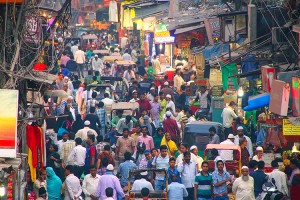India Becomes the World’s Most Populous Country
Thursday, July 6th, 2023In late April 2023, India claimed the title of the world’s most populous country. Nearly 2.9 million more people live in India than China, which held the title since 1950. A densely populated country, about a sixth of the 8 billion person global population resides in India, the seventh largest country in size. There are around 1.4 billion people in India. As the population of India continues growing, many other countries face a stagnant population or even decreasing numbers. According to the United Nations, India’s population is expected to peak at 1.7 billion in 2064. The rapid growth brings challenges in education, infrastructure, and jobs.
While the birth rate, or children per woman, of many countries around the world keeps declining, India’s population keeps growing. In 1970, China and India had similar birth rates of 5.8 in China and 5.72 in India. India’s birth rate dropped from 6 in the 1960’s to 3.4 in 1992. India’s birth rate further dropped to 2 in 2021. Despite this fertility rate decrease, India continues to grow because the average family in the 1960’s had 6 children. Those children are now parents and grandparents. India’s Prime Minister Narendra Modi spoke in 2019 about controlling India’s population growth by encouraging limiting the number of children in a family.
A country’s average fertility rate must be 2.1 to maintain a population. Decades of limiting families to one child in China halted the population growth. India also established measures to curb rapid population growth, but the decline in the birth rate was more gradual compared to China’s. China’s birth rate fell to 1.2 in 2022, the nation’s lowest ever, despite the end of one-child policies in 2016. Throughout the world, the COVID-19 pandemic coincided with lower birth rates.
Many populations are aging throughout the world. The median age of a country shows at what age half the population is older and half is younger. In 2022, India’s median age of 28.7 was almost a decade lower than China’s 38.4. According to the Census Bureau, the median age in the United States reached a record high of 38.9 years in 2022. Since the birth rate has declined, the median age will continue growing older. The populations of India and China over the age of 65 will double by 2050. As healthcare and other survival measures improve and the birth rates fall, the number of people over the age of 65 is increasing in many countries. Aging populations strain economies as older citizens retire from work and require medical care and other assistance.
With such rapid population growth, unemployment levels have risen. In 2021, India’s working-age population contained 900 million people. It is projected that number will hit 1 billion in several years. Many cannot find work and have to travel or move to find secure employment. While India’s fast-growing economy has become the fifth largest in the world, the wealth is not spread evenly across the country. Its gross domestic product (GDP), a measure of a healthy economy, is high. Dividing India’s high GDP by its large population reveals an extremely low per capita GDP. Due to its low per capita GDP, India is still considered a developing country and one of the poorest nations in the world.
The Indian government is incentivizing living in smaller towns as the larger cities deal with pollution and rising temperatures. By improving infrastructure and public transportation, Prime Minister Narendra Modi hopes to encourage migration to smaller towns. The population has outgrown India’s transportation systems. In June 2023, a train crash in Odisha killed more than 261 people. The trains were packed with people, with many standing for the entire trip. The trains were so crowded that it hindered rescue efforts.
Many experts believe improving education for women across India will solve many of its problems. World Bank data shows that only 19 percent of women in India participated in the workforce in 2021. By providing education for women after primary school, they can help lead India into the future. If more women receive an education and enter the workforce, the birth rate will decline further, improving the quality of life and strength of democracy in India.



